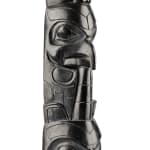-
Artworks
UNIDENTIFIED ARTIST, HAIDA
Model Totem, c. 1900argillite, 18.25 x 3.75 x 3.25 in (46.4 x 9.5 x 8.3 cm)
unsigned.
LOT 20
ESTIMATE: $15,000 — $25,000
PRICE REALIZED: $22,800.00Further images
Thunderbird, Eagle, and Beaver appear to be the main figures on this large model. The strongly recurved beak on the top figure indicates a Thunderbird image, this one shown with...Thunderbird, Eagle, and Beaver appear to be the main figures on this large model. The strongly recurved beak on the top figure indicates a Thunderbird image, this one shown with a small crouching human perched between its wings and the upright ears of the bird image below it. The beak of that bird bends down but not back on itself, suggesting this is an eagle. The wing designs on each of these birds are made up of simple ovoids and solid U-shapes separated by crescents, with these details somewhat crudely defined. Between the eagle’s wings is a tall stack of hat rings, known as skils, a symbol of high status often shown in association with the beaver crest. The large beaver in this case has the exaggerated incisor teeth that define the image, but no stick held in the paws such as can be seen in some other renderings of the beaver crest. This one sits on its haunches with its forelegs draped over its knees. The backside of this pole has been hollowed out to lighten the overall weight of the carving.
Steven C. Brown
A model totem pole of imposing height and impressive proportions, this example has an integral base and a concave back. The earliest documented argillite poles, in the Pitt Rivers Museum in Oxford, England, were collected in 1865. The first examples were fairly modest in size, but over the years their scale gradually grew until by the 1880s some examples had reached heights of between 50 and 100 centimetres. By 1900 the poles began to grow smaller again, and their backs were left flat rather than hollowed. They also looked less like copies of actual poles, and typically presented fewer and so relatively larger figures. This pole probably dates from just around this transitional date of 1900.
References: For the section on argillite late model poles see Peter L. Macnair and Alan J. Hoover, The Magic Leaves: A History of Haida Argillite Carving (Victoria: Royal BC Museum, 1984/2002), pp. 127-138. See also Leslie Drew and Douglas Wilson, Argillite: Art of the Haida (Vancouver: Hancock House, 1980), pp. 216-227.
Provenance
Ex. Collection of Vivian and Meyer Potamkin, NY;
Sotheby's, NY, Furniture, Decorative and Fine Arts from the Collection of Meyer and Vivian Potamkin, May 2003;
A Vancouver Collection.
Join our mailing list
* denotes required fields
We will process the personal data you have supplied in accordance with our privacy policy (available on request). You can unsubscribe or change your preferences at any time by clicking the link in our emails.












